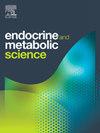早期诊断妊娠期糖尿病妇女的生化、实验室和仪器诊断指标
Q3 Medicine
引用次数: 0
摘要
妊娠期糖尿病(GDM)是一种糖尿病,可以在没有糖尿病的妇女怀孕期间发展。我们研究了两个研究组(36名健康孕妇和68名GDM孕妇)血液中同型半胱氨酸的浓度。研究内容包括生化指标(同型半胱氨酸、葡萄糖、肌酐、糖化血红蛋白)、激素指标(瘦素、c肽、25 (OH) D)以及相关和统计研究方法。根据分组患者病历中的血液分析,平均61.45%的患者出现贫血。同型半胱氨酸是控制孕妇体内叶酸作用的生物标志物,其参考值在5.6-16.42 μmol/l之间,而在健康妇女中,该诊断指标的平均值为12.98±0.31。GDM孕妇同型半胱氨酸平均值为42.87±2.26 μmol/l (P≤0.001)。GDM孕妇的另一个特异性标志物是对胆钙化醇、维生素25(OH) d的研究,发现GDM孕妇组与对照组的指标差异的显著性水平几乎是对照组的2倍。基于这一发现,在未来的研究中,可以检验这些指标对GDM发生的预测价值。研究还发现,与对照组相比,GDM患者的这些指标有显著差异,尽管需要在更广泛的人群中进行进一步的研究来证实这一点。本文章由计算机程序翻译,如有差异,请以英文原文为准。

Biochemical, laboratory and instrumental diagnostic indicators of early diagnosis of women with gestational diabetes
Gestational diabetes (GDM) is a type of diabetes that can develop during pregnancy in women who don't have diabetes. We studied the concentration of homocysteine in the blood in two study groups - 36 healthy pregnant women and 68 pregnant women with GDM. The study included biochemical (homocysteine, glucose, creatinine, glycated hemoglobin), hormonal (leptin, C-peptide, 25 (OH) D, and methods of correlation and statistical research. According to the analysis of blood in the case histories of patients in groups, anemia was observed in an average of 61.45 % of patients. Homocysteine is a biomarker that controls the action of folic acid in the body in pregnant women, the reference values of which are in the range of 5.6–16.42 μmol/l, while in healthy women this diagnostic indicator averages 12.98 ± 0.31. The mean homocysteine value in pregnant women with GDM was 42.87 ± 2.26 μmol/l (P ≤ 0.001). Another specific marker in pregnant women with GDM is the study of cholecalciferol, vitamin 25(OH) D. It was found that the level of significance of the difference between the indicators in the group of pregnant women with GDM and in the control group was almost 2 times less. Based on this finding, in future studies, the predictive value of each of these indices in the occurrence of GDM can be examined. It was also found that such indices differ significantly in patients with GDM compared to the control group, although further studies in the broader population are needed to confirm this.
求助全文
通过发布文献求助,成功后即可免费获取论文全文。
去求助
来源期刊

Endocrine and Metabolic Science
Medicine-Endocrinology, Diabetes and Metabolism
CiteScore
2.80
自引率
0.00%
发文量
4
审稿时长
84 days
 求助内容:
求助内容: 应助结果提醒方式:
应助结果提醒方式:


